Contents
With the arrival of really cold weather, providing heat and heating the chicken coop in winter becomes a condition for the survival of the entire poultry population. Despite good adaptation to weather changes, the chicken is prone to colds and infectious diseases, like any domestic animal, so heating in the chicken coop in winter becomes a serious problem.

How to keep warm in a chicken coop
In addition to lining the chicken coop with a highly effective polymer or mineral-based insulation, the normal temperature inside the chicken apartments can be maintained in three ways:
- Installing a heater
- Use the heat of a residential building for heating;
- Apply chemical or additional heat sources.
A comfortable temperature can be called at 15-17оC. At the same time, it will be necessary to simultaneously ensure a normal supply of fresh air and humidity in the chicken coop at a level of no more than 60%.
Folk heating options
The simplest folk way to organize the heating of a chicken coop is the correct location of the room relative to the residential building. Most often, the chicken coop was attached to the side of the stove, so that the heat from the wall warmed up the room with the bird. Thus, the problem of how to heat the chicken coop in winter, even in the most severe frosts, was solved quite simply and without electricity.
The second popular way to heat a poultry room is considered to be the use of decomposing chicken manure with sawdust. But such a heater often leads to a massive death of the birds in the chicken coop by the emitted gases, so today it can only be found in greenhouses and to maintain artificial mycelium.
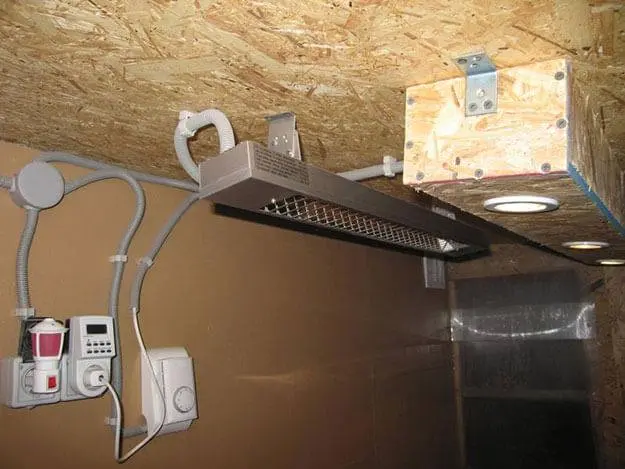
What is more profitable for heating – electricity or fuel
Any heating options using alternative energy sources can only keep the heat in the chicken house at an acceptable level, provided that the air temperature outside is not lower than -10оC. In more severe frosts, the problem of how to heat the chicken coop can be solved either by installing an electric heater in the room, or by a fossil fuel stove. Heat pipes and solar heaters in these conditions will be so expensive that their purchase and installation will cost three times as much as the chicken coop itself with chickens to boot.
Electrical heating systems
The most voracious are electric wall convectors. The principle of their operation resembles an ordinary fireplace, most of the heated air rises to the ceiling, and the lower layers, which are fundamentally important for the chicken tribe, remain cold. The difference in air temperature can reach 6-8оS. So, even having paid almost two thousand rubles a month, there is still a risk of underheating the chicken coop using an inappropriate heating method.
In second place are infrared heaters installed in the ceiling of the room. Unlike previous models, infrared heating devices can provide a number of additional benefits:
- Heating of space, air and objects takes place in the lower tier of the chicken coop, energy is distributed more rationally.
- The location of the heating element is absolutely safe for birds.
- Thermal radiation sterilizes and dries the condensate film and bedding, improving the sanitary condition of the chicken coop.
The heater power of 600 W is enough to heat the insulated chicken coop room of 5-6 m2. Usually, a two-position heater with a thermostat is used for heating, which has two heating modes – 600 W and 1200 W. In this case, the heating of the poultry room has to be adjusted by hand using a manual thermostat.
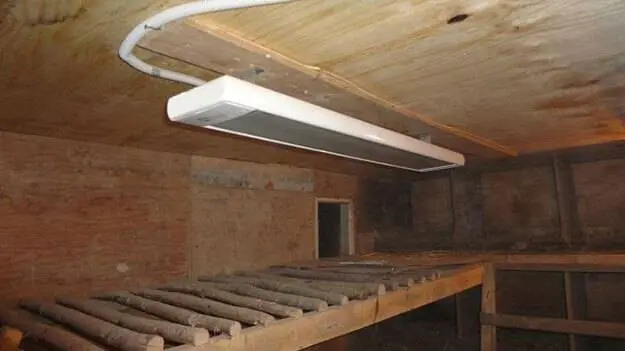
If possible, it is better to choose a more modern model that allows you to smoothly change the load and the level of heating of the room at the signal of a remote air temperature sensor.
Farmers and summer residents who breed poultry for sale prefer to choose a programmable energy-saving heater that can provide heating for the chicken coop depending on the time of day. Due to the correctly selected mode, energy savings can be up to 60%. Which heater option to choose for heating depends on the size and characteristics of a particular chicken coop room.
The disadvantages of an infrared heater include high power consumption and the burning of oxygen in the atmosphere of the room. In addition, if most of the interior decoration, perch and floor is made of wood, with severe overheating, the wooden surface will dry out and become cracked over time. The best way to protect wood from “burning out” is to coat the wood with two coats of clear oil varnish.

In third place are infrared lamps. The principle of operation of the lamp is in many ways similar to the operation of an infrared heater, but is less efficient due to the harder radiation that is scattered throughout the room. Heating with a lamp is most often used in rooms for young animals and the children’s section of the chicken coop, where, in addition to heating, it is important to use the disinfecting properties of the lamp.
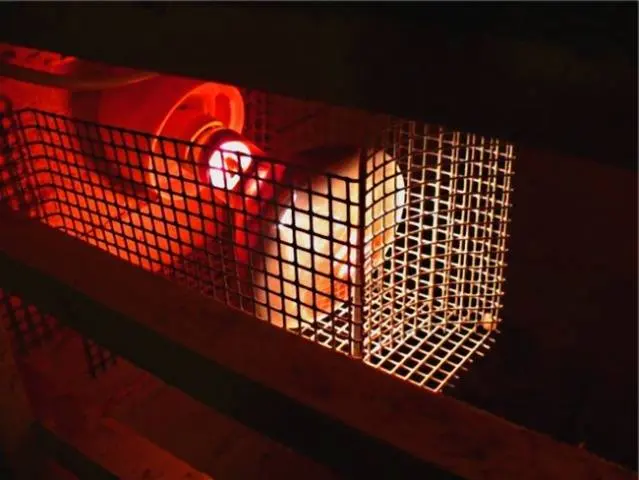
For heating 5-7 m2 indoors, a standard “red” lamp IKZK215 with a mirror reflector is usually used. In theory, the service life of such a heater is designed for 5000 hours, but in practice it lasts for one season.
The most exotic option for heating the chicken coop are film electric heaters, which are widely used for arranging underfloor heating. In this case, the heater is laid on a heat-insulating mat, and the heating surface is covered with a wooden board impregnated with a lacquer composition.
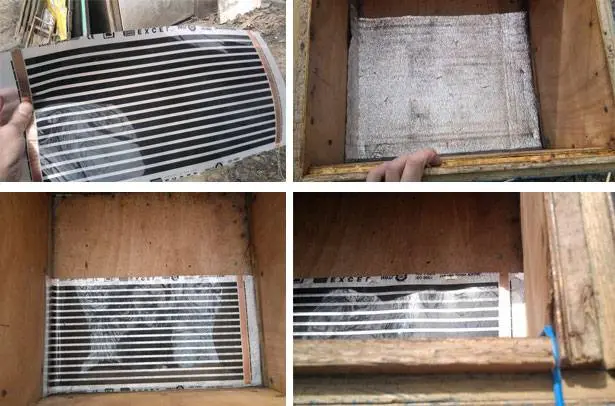
Film heaters can be laid on walls and even on the ceiling, but the most effective heating will be with the installation of the heating part on the floor of the chicken coop.
Of all the listed heating options, a film heater can be called the most economical and energy-efficient system; energy consumption compared to infrared heating will decrease by 15-20%.
Furnaces and heaters on organic fuel
It is not always possible to choose how to heat the chicken coop in the winter. For example, in a summer cottage or in a country house in winter, electricity can be turned off several times a week, which can lead to the death of a bird.
In this case, stone stoves are used for heating, which are attached to the outside of the chicken coop wall in a separate room. The stove has a massive brick heating shield, which acts as one of the walls of the chicken coop. At night, the room is heated to a high temperature, a small amount of coal is placed in the furnace, and until midnight it will be +17 in the chicken coopоC. Further, heating is carried out due to the heat accumulated by the brickwork.
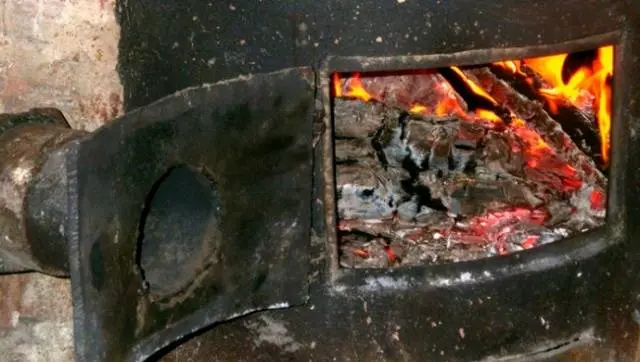
A self-heating stove using used engine oil is considered safer and easier to manufacture. But the apparatus itself is not placed inside the chicken coop for reasons of fire safety. Heating of the room is carried out using a large water tank or a two-hundred-liter barrel filled with water. Inside the barrel, a steel pipe is installed, bent at the knee, through which flue gases and combustion products of oil from the stove are sent to the chimney.
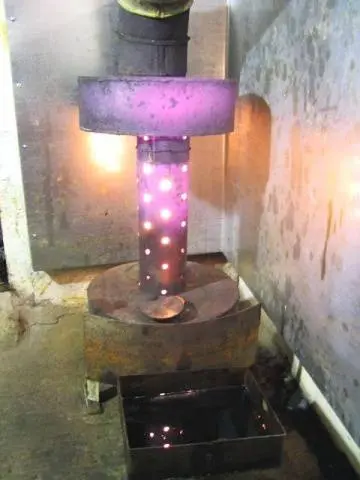
For heating, 1,5-2 liters of mining are filled into the furnace tank, which is enough for a couple of hours of operation. During this time, the water in the barrel warms up to a high temperature. At the end of the fuel supply, the heating of the chicken coop is carried out due to the heat accumulated by the water.
Conclusion
Often, home-made thermal panels made of steel or aluminum pipes are added to stationary stoves and heaters using electricity or fossil fuels. Such a system, installed on the roof of a chicken coop, can reduce the energy consumption for heating during the daytime by 70-80%.









